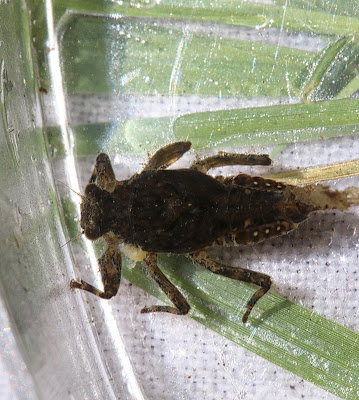But first things first. A beautiful, fairly mature, common stonefly, Paragnetina immarginata. Think I've found one in Entry Run before but they're more common in the Rapidan River. TV 1.1.
Drunella spiny crawlers. Today I found both D. cornutella and D. tuberculata. Drunella seems to be the only spiny around at the moment. The more common Ephemerella nymphs have already hatched. Drunella nymphs are by far less tolerant of stream impairment. The tolerance value of both of our species -- cornutella and tuberculata -- is 0.0.
__________________
Distinguishing features? Two things stand out: "head smooth with moderately long lateral frontoclypeal projections but less than half as long as the distance between them; median ocellar tubercle blunt to moderately sharp." Yep.
_________________
Drunella tuberculata. Less common than cornutella and somewhat bigger (this one was 8-9 mm). Key features for the ID of this species are, in addition to the fact that it lacks the lateral frontoclypeal projections, "head with long occipital tubercles not divergent apically ... abdomen with paired dorsal tubercles always well developed on segments 5-7." (Beaty, p. 25) You can see the occipital tubercles on the nymph in the photo above, but this microscope photo is better.
Abdominal tubercles as you can see are present on terga 3-8 and definitely prominent on 4-7.
Drunellas apparently hatch as "Eastern Blue-winged Olives" for us fly fishermen. I can't imagine that's is a "blizzard" out there when they do! But they'll be big. You can probably get away with a size 14 hook, maybe even a 12.
Providing much better hatches of BWO's are the Baetidaes -- small minnow mayflies -- and we see a lot of them in the summer, and a lot of different species. Today I found one of my favorites: Acentrella nadineae.
This one was fully mature, in fact, I think it hatched while I was taking photos of other insects. In any event it was not in my bowl when I went to release it -- and there was a shuck floating on top of the water! You may recall that this happened to me before. 9/16/14, Rapidan River.
Olive body, bluish gray wings.
Two things help us with this species ID. First look at the gills. "gills elongate asymmetrical, and with basomedial pigmentation splotches." (Beaty, "The Ephemeroptera of North Carolina," p.4)
And second, "distinct abdominal color pattern often tinged with red." (Beaty, p.4) While we can see that on this nymph, it is much clearer on a nymph that is not this mature (and therefore not so dark).
Gorgeous.
_________________
I'm seeing fewer and fewer insects now in our small mountain streams. Time to get down to the Rivanna.













No comments:
Post a Comment